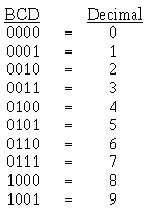1-59
Q106.
3E6.516
BINARY-CODED DECIMAL
In today’s technology, you hear a great deal about microprocessors. A microprocessor is an
integrated circuit designed for two purposes: data processing and control.
Computers and microprocessors both operate on a series of electrical pulses called words. A word
can be represented by a binary number such as 101100112. The word length is described by the number of
digits or BITS in the series. A series of four digits would be called a 4-bit word and so forth. The most
common are 4-, 8-, and 16-bit words. Quite often, these words must use binary-coded decimal inputs.
Binary-coded decimal, or BCD, is a method of using binary digits to represent the decimal digits 0
through 9. A decimal digit is represented by four binary digits, as shown below:
You should note in the table above that the BCD coding is the binary equivalent of the decimal digit.
Since many devices use BCD, knowing how to handle this system is important. You must realize
that BCD and binary are not the same. For example, 4910 in binary is 1100012, but 4910 in BCD is
01001001BCD. Each decimal digit is converted to its binary equivalent.
BCD Conversion
You can see by the above table, conversion of decimal to BCD or BCD to decimal is similar to the
conversion of hexadecimal to binary and vice versa.
For example, let’s go through the conversion of 26410 to BCD. We’ll use the block format that you
used in earlier conversions. First, write out the decimal number to be converted; then, below each digit
write the BCD equivalent of that digit:

